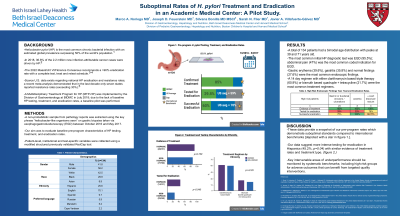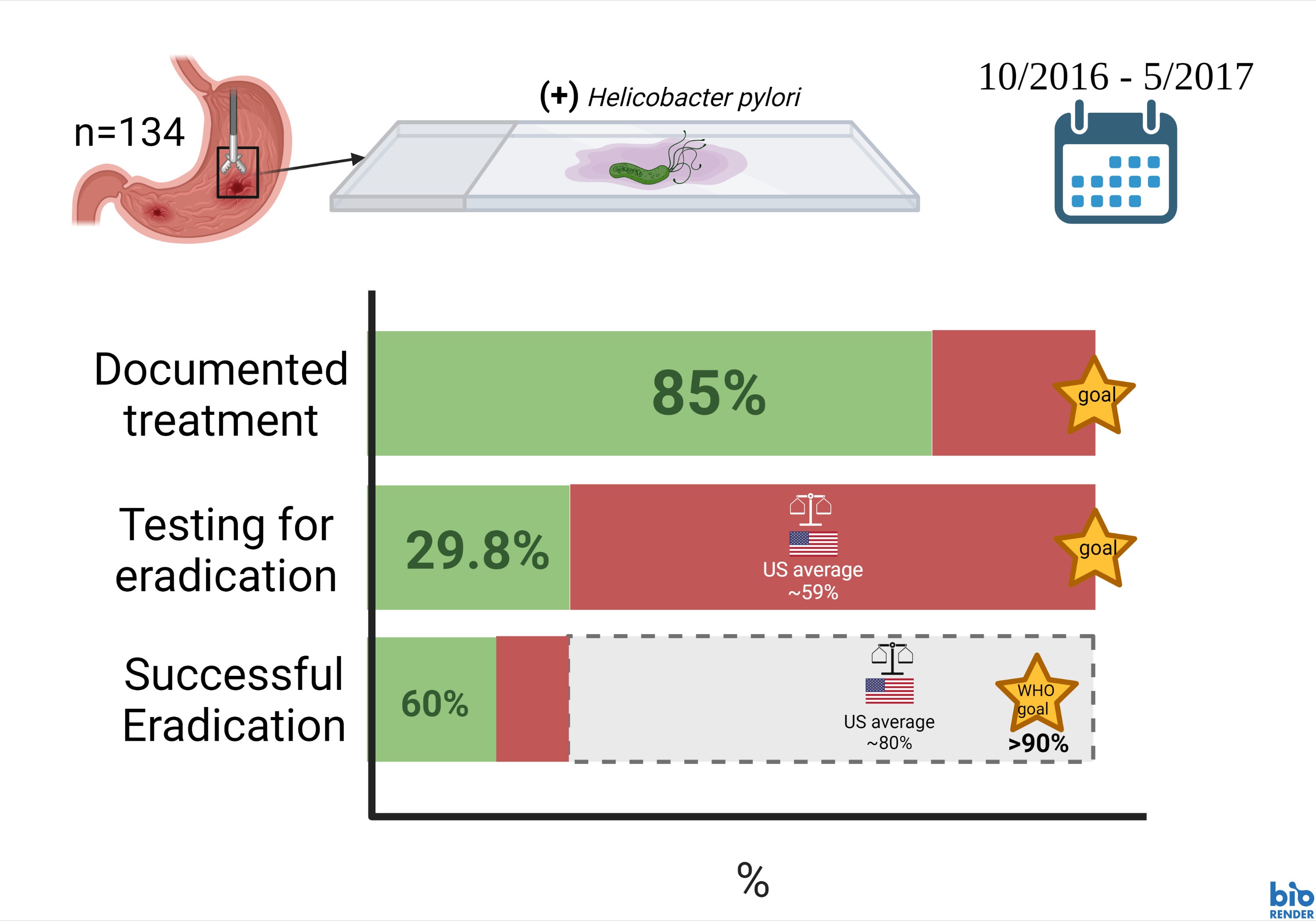Back


Poster Session D - Tuesday Morning
Category: Stomach
D0684 - Suboptimal Rates of H. pylori Treatment and Eradication in an Academic Medical Center: A Pilot Study
Tuesday, October 25, 2022
10:00 AM – 12:00 PM ET
Location: Crown Ballroom

Has Audio

Marco A. Noriega, MD
BIDMC/HMS
Boston, MA
Presenting Author(s)
Marco A. Noriega, MD1, Joseph D. Feuerstein, MD2, Silvana Bonilla, MD, MSCI3, Sarah N. Flier, MD1, Javier A. Villafuerte-Gálvez, MD1
1BIDMC/HMS, Boston, MA; 2Beth Israel Deaconess Medical Center (BIDMC), Boston, MA; 3Boston Children's Hospital/HMS, Boston, MA
Introduction: Nearly half of humans are colonized by Helicobacter pylori (HP) with only 20% developing digestive symptoms during their lifetime. The World Health Organization (WHO) considers HP a carcinogen and a high-priority pathogen in terms of antimicrobial resistance. National guidelines support treatment followed by assessment of successful eradication as quality measures. The rates of HP treatment, testing for eradication, and successful eradication at our institution are unknown. A pilot study was undertaken to estimate these quality benchmarks.
Methods: A non-probabilistic sample of patients from an academic medical center in the Northeastern United States was selected. The inclusion criterion was having ≥1 pathology billing diagnostic code for HP between October 2016 and May 2017. Patient-level data including demographics, patient care notes, laboratory tests, prescription records, endoscopy, and pathology reports, were reviewed with a modified validated and structured tool.
Results: Females amounted to 58.2% (78/134) of patients, 42.5% (57/134) of patients identified as White, and 23.3% (31/134) as Hispanic. English was the preferred language for 70.1% (94/134) of patients. Gastric erythema (n=53, 39.6%) and gastritis (n=48, 35.8%) were the most common reported endoscopic findings. Eighty-five percent (114/134) of patients had documentation of receiving treatment for HP. Overall, 29.8% (40/134) had documentation of testing for eradication, of which 60% (24/40) achieved successful eradication (See Figure 1).
Discussion: Our study indicates that nearly one in six patients had no documented treatment for HP, less than a third of patients had documented eradication testing (national average ~59%), and the successful eradication rate was 60% (national average ~80%, WHO goal >90%). Our findings support the need for interventions to improve performance in these three quality benchmarks such as a Multidisciplinary Treatment Program for HP.

Disclosures:
Marco A. Noriega, MD1, Joseph D. Feuerstein, MD2, Silvana Bonilla, MD, MSCI3, Sarah N. Flier, MD1, Javier A. Villafuerte-Gálvez, MD1. D0684 - Suboptimal Rates of H. pylori Treatment and Eradication in an Academic Medical Center: A Pilot Study, ACG 2022 Annual Scientific Meeting Abstracts. Charlotte, NC: American College of Gastroenterology.
1BIDMC/HMS, Boston, MA; 2Beth Israel Deaconess Medical Center (BIDMC), Boston, MA; 3Boston Children's Hospital/HMS, Boston, MA
Introduction: Nearly half of humans are colonized by Helicobacter pylori (HP) with only 20% developing digestive symptoms during their lifetime. The World Health Organization (WHO) considers HP a carcinogen and a high-priority pathogen in terms of antimicrobial resistance. National guidelines support treatment followed by assessment of successful eradication as quality measures. The rates of HP treatment, testing for eradication, and successful eradication at our institution are unknown. A pilot study was undertaken to estimate these quality benchmarks.
Methods: A non-probabilistic sample of patients from an academic medical center in the Northeastern United States was selected. The inclusion criterion was having ≥1 pathology billing diagnostic code for HP between October 2016 and May 2017. Patient-level data including demographics, patient care notes, laboratory tests, prescription records, endoscopy, and pathology reports, were reviewed with a modified validated and structured tool.
Results: Females amounted to 58.2% (78/134) of patients, 42.5% (57/134) of patients identified as White, and 23.3% (31/134) as Hispanic. English was the preferred language for 70.1% (94/134) of patients. Gastric erythema (n=53, 39.6%) and gastritis (n=48, 35.8%) were the most common reported endoscopic findings. Eighty-five percent (114/134) of patients had documentation of receiving treatment for HP. Overall, 29.8% (40/134) had documentation of testing for eradication, of which 60% (24/40) achieved successful eradication (See Figure 1).
Discussion: Our study indicates that nearly one in six patients had no documented treatment for HP, less than a third of patients had documented eradication testing (national average ~59%), and the successful eradication rate was 60% (national average ~80%, WHO goal >90%). Our findings support the need for interventions to improve performance in these three quality benchmarks such as a Multidisciplinary Treatment Program for HP.

Figure: Figure Made in BioRender.com
Disclosures:
Marco Noriega indicated no relevant financial relationships.
Joseph Feuerstein indicated no relevant financial relationships.
Silvana Bonilla indicated no relevant financial relationships.
Sarah Flier indicated no relevant financial relationships.
Javier Villafuerte-Gálvez indicated no relevant financial relationships.
Marco A. Noriega, MD1, Joseph D. Feuerstein, MD2, Silvana Bonilla, MD, MSCI3, Sarah N. Flier, MD1, Javier A. Villafuerte-Gálvez, MD1. D0684 - Suboptimal Rates of H. pylori Treatment and Eradication in an Academic Medical Center: A Pilot Study, ACG 2022 Annual Scientific Meeting Abstracts. Charlotte, NC: American College of Gastroenterology.
